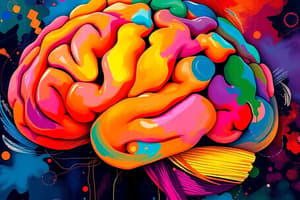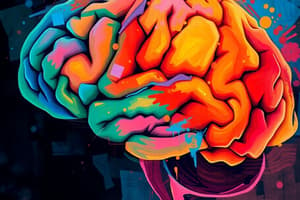Podcast
Questions and Answers
What triggers the fusion of synaptic vesicles with the axon terminal membrane?
What triggers the fusion of synaptic vesicles with the axon terminal membrane?
- Increased neurotransmitter concentration
- Signal transduction from the postsynaptic cell
- Decreased membrane potential
- Ca2+ influx into the axon terminal (correct)
What effect does an excitatory postsynaptic potential (EPSP) have on the receiving cell?
What effect does an excitatory postsynaptic potential (EPSP) have on the receiving cell?
- Causes complete depolarization of the membrane
- Decreases the neurotransmitter binding capacity
- Inhibits neurotransmitter release from the presynaptic cell
- Increases the likelihood of action potential firing (correct)
Which mechanism is involved in clearing neurotransmitters from the synaptic cleft?
Which mechanism is involved in clearing neurotransmitters from the synaptic cleft?
- Reuptake by glial cells
- Diffusion through the extracellular space
- Proteolytic cleavage into amino acids
- Enzymatic degradation or reuptake into presynaptic neurons (correct)
Which of the following is NOT a type of supporting cell in the central nervous system?
Which of the following is NOT a type of supporting cell in the central nervous system?
How are neurotransmitters classified?
How are neurotransmitters classified?
What function does the primary motor cortex primarily serve?
What function does the primary motor cortex primarily serve?
Which area of the cerebral cortex is responsible for task-related processing and coordination of muscle groups?
Which area of the cerebral cortex is responsible for task-related processing and coordination of muscle groups?
What is the role of multimodal association areas in the cerebral cortex?
What is the role of multimodal association areas in the cerebral cortex?
Which sensory area detects sensory information regarding temperature, proprioception, and pain?
Which sensory area detects sensory information regarding temperature, proprioception, and pain?
The loss of which sensory ability may serve as an early sign of Alzheimer's disease?
The loss of which sensory ability may serve as an early sign of Alzheimer's disease?
Which area of the brain is responsible for integrating sensory inputs from the primary somatosensory cortex?
Which area of the brain is responsible for integrating sensory inputs from the primary somatosensory cortex?
In regards to the structure of the cerebral cortex, which functional area is NOT classified as a motor area?
In regards to the structure of the cerebral cortex, which functional area is NOT classified as a motor area?
What role does the posterior association area play in the brain?
What role does the posterior association area play in the brain?
What is the primary role of norepinephrine in the central nervous system?
What is the primary role of norepinephrine in the central nervous system?
Which pathway is associated with the transport of dopamine from the substantia nigra to the striatum?
Which pathway is associated with the transport of dopamine from the substantia nigra to the striatum?
Which receptor type for norepinephrine serves as an autoreceptor that inhibits neurotransmitter release?
Which receptor type for norepinephrine serves as an autoreceptor that inhibits neurotransmitter release?
What is the starting amino acid required for the synthesis of dopamine?
What is the starting amino acid required for the synthesis of dopamine?
Which enzymes are primarily involved in the metabolism of dopamine?
Which enzymes are primarily involved in the metabolism of dopamine?
What distinguishes ligand-activated ion channels from metabotropic receptors in terms of response time?
What distinguishes ligand-activated ion channels from metabotropic receptors in terms of response time?
Which of the following neurotransmitter receptors is primarily associated with indirect ion channel modulation?
Which of the following neurotransmitter receptors is primarily associated with indirect ion channel modulation?
In the context of the reward system, which structure is NOT typically activated during rewarding experiences?
In the context of the reward system, which structure is NOT typically activated during rewarding experiences?
Which of the following best describes the role of second messengers in metabotropic receptor signaling?
Which of the following best describes the role of second messengers in metabotropic receptor signaling?
What is the primary difference between heteroreceptors and autoreceptors?
What is the primary difference between heteroreceptors and autoreceptors?
What is the primary function of the blood-brain barrier?
What is the primary function of the blood-brain barrier?
Which statement accurately describes the organization of the spinal cord's gray matter?
Which statement accurately describes the organization of the spinal cord's gray matter?
What role do synaptic vesicles play in neurotransmission?
What role do synaptic vesicles play in neurotransmission?
What occurs when an action potential reaches the axon terminal of a neuron?
What occurs when an action potential reaches the axon terminal of a neuron?
In the context of the spinal cord, which type of information is carried by the ascending white matter tracts?
In the context of the spinal cord, which type of information is carried by the ascending white matter tracts?
How many layers must substances in the blood pass through to reach the neurons?
How many layers must substances in the blood pass through to reach the neurons?
What is the synaptic cleft?
What is the synaptic cleft?
What is the function of the dorsal root in the spinal cord?
What is the function of the dorsal root in the spinal cord?
Flashcards are hidden until you start studying
Study Notes
Cerebral Cortex
- Consists of three functional areas: motor, sensory, and multimodal association
- Motor areas include the primary motor cortex, premotor cortex, and Broca's area
- All neurons in the cerebral cortex are interneurons
Motor Areas
- Primary motor cortex controls individual movements or sequences of movements requiring multiple muscle groups
- Premotor cortex sends axons to the primary motor cortex and spinal cord, performing more complex task-related processing
- Broca's area is involved in speech production
Sensory Areas
- Primary somatosensory cortex detects sensory information from the body including temperature, proprioception, touch, texture, and pain
- Somatosensory association cortex integrates sensory inputs received from the primary somatosensory cortex, leading to an understanding of the object being felt
Multimodal Association Areas
- Receive input from multiple senses and output to multiple areas
- Help us give meaning to information received, store it in memory, tie it to previous experience, and decide on actions
- Include the Anterior association area (prefrontal cortex), Posterior association area, and Limbic association area.
Blood Brain Barrier
- Helps maintain a stable environment in the brain by preventing exposure to chemical variations that may influence neuronal firing
- Tight junctions between capillary endothelial cells create an exceptionally impermeable barrier
- Substances in the blood must pass through three layers before reaching neurons
- Permeability is selective, some substances can diffuse easily and affect the brain.
Meninges and Spinal Cord
- Meninges cover the spinal cord
- Nerves exit at the level of each vertebrae
- Dorsal root is associated with the dorsal root ganglia, cell bodies outside the central nervous system
- Ventral root carries motor information
- Spinal cord's gray matter consists of sensory and motor nuclei
- White matter consists of axons carrying information to and from the brain.
- Ascending axons carry sensory inputs up to higher centers
- Descending axons carry motor outputs down to lower centers
- Transverse axons transfer information across the cord.
Neuron Synapse
- Axonal terminals contain vesicles with neurotransmitters
- Axon terminals are separated from the next neuron by the synaptic cleft
- Synapse refers to the junction between nerves
Transmission at Chemical Synapses
- A single axon can have multiple branches, synapsing on various postsynaptic cells
- A single neuron receives thousands of synaptic inputs from multiple presynaptic neurons
- Synaptic vesicles contain neurotransmitters
- Action potentials activate voltage-gated calcium channels in the axon terminal membrane
- Calcium influx triggers fusion of synaptic vesicles with the membrane and neurotransmitter release into the synaptic cleft
- Neurotransmitter binds to receptors on the postsynaptic cell, opening or closing ion channels
- This change in ion permeability leads to an excitatory postsynaptic potential (EPSP) if the cell is made more likely to fire or an inhibitory postsynaptic potential (IPSP) if it is made less likely to fire
Signal Termination
- Neurotransmitters are cleared from the synaptic cleft by different mechanisms:
- Enzymatic degradation (e.g. acetylcholine)
- Reuptake into the presynaptic neuron for recycling (e.g. serotonin)
Supporting Cells (Glial Cells) of the Nervous Tissue
- Besides neurons, the CNS also contains several different cell types including:
- Astrocytes
- Microglia
- Ependymal cells
- Oligodendrocytes
Neurotransmitters
- Play a role in emotion, hunger, satiation, memory, movement, and even smiling
- Over 50 neurotransmitters have been identified
- Some neurons produce and release one type of neurotransmitter, while most produce two or more
- Can be classified by chemical structure or function
- Norepinephrine is generally excitatory and involved in vigilance and attentiveness
- Dopamine is involved in reward, movement, and motivation.
- Serotonin is involved in mood, sleep, and appetite
- Different receptors, including ionotropic and metabotropic receptors, bind to neurotransmitters and mediate their effects.
Heteroreceptors
- Receptors on the presynaptic terminal of one neuron that are activated by a neurotransmitter released from another neuron
- They modulate the release of the neurotransmitter from that presynaptic terminal
Autoreceptors
- Receptors located on the presynaptic terminal of a neuron that bind to the neurotransmitter released by that same neuron
- They typically have an inhibitory effect, reducing the release of the neurotransmitter.
The Reward System
- A group of structures that are activated when we experience something rewarding
- Major components and functions:
- Ventral tegmental area (VTA): Produces dopamine
- Nucleus accumbens: Receives dopamine and is involved in pleasure and motivation
- Amygdala: Processes emotions, including fear and reward
- Hippocampus: Involved in memory formation
- Prefrontal cortex: Controls executive functions, including decision-making, planning, and impulse control
Studying That Suits You
Use AI to generate personalized quizzes and flashcards to suit your learning preferences.




